2009 Spring Baseball Roundup
Baseball Books
2009 Spring Baseball Roundup

New Books Look at the Good and Bad in the National Pastime
There have been lots of happy moments in the 150-plus-year history of baseball. But there have also been some devastating ones. Both are represented among this year’s assortment of books.
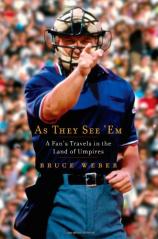 One of the best in recent years is Bruce Weber’s AS THEY SEE ’EM: A Fan’s Travels in the World of Umpires, an ode to the men in blue. Weber “imbedded” himself in his assignment, attending one of the professional schools, interviewing the aspirants, and giving a sympathetic view about how hard the profession can be. There are 750 ballplayers in the Major Leagues, but only about 80 umpires to keep everything under control on the field. The competition and pressure to advance is intense, especially since the ones at the Major League level seem to hold on to their jobs for as long as possible.
One of the best in recent years is Bruce Weber’s AS THEY SEE ’EM: A Fan’s Travels in the World of Umpires, an ode to the men in blue. Weber “imbedded” himself in his assignment, attending one of the professional schools, interviewing the aspirants, and giving a sympathetic view about how hard the profession can be. There are 750 ballplayers in the Major Leagues, but only about 80 umpires to keep everything under control on the field. The competition and pressure to advance is intense, especially since the ones at the Major League level seem to hold on to their jobs for as long as possible.
After reading AS THEY SEE ’EM, I would be surprised if the thoughtful reader sees the game the same way. While TV viewers have the benefit of instant replay, the umpires have to make split-second decisions that can have long-range repercussions. The money is poor at the lower levels, and chance for advancement can hinge on a simple personality flaw or tic. No one is the umpire’s friend, and for them there are no home games. Weber, a writer for The New York Times, does an excellent job in humanizing these men.
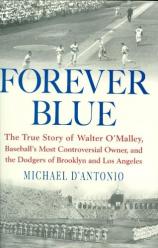 Another topic that goes beyond the “flavor of the month” topic is Michael D’Antonio’s FOREVER BLUE: The True Story of Walter O’Malley, Baseball’s Most Controversial Owner, and the Dodgers of Brooklyn and Los Angeles. For Brooklyn Dodger fans, there was no darker moment than when their beloved team announced they would move to California following the 1957 season. O’Malley was pilloried in the press, named as one of the three most hated men in history along with Hitler and Stalin. But D’Antonio thinks the executive got a bum rap and seeks to prove that is simply not a fair conclusion.
Another topic that goes beyond the “flavor of the month” topic is Michael D’Antonio’s FOREVER BLUE: The True Story of Walter O’Malley, Baseball’s Most Controversial Owner, and the Dodgers of Brooklyn and Los Angeles. For Brooklyn Dodger fans, there was no darker moment than when their beloved team announced they would move to California following the 1957 season. O’Malley was pilloried in the press, named as one of the three most hated men in history along with Hitler and Stalin. But D’Antonio thinks the executive got a bum rap and seeks to prove that is simply not a fair conclusion.
O’Malley was destined for success. A lawyer by training, he became involved with the Dodgers in his mid-30s and gradually took over the team. He was a forward thinker, looking for ways to improve the Dodgers’ home, Ebbets Field, and make the baseball experience more enjoyable for the fans as well as more profitable. It’s hard to believe, but despite the team’s success in the standings through the post-war years, the ledger showed they were often surpassed financially by weaker teams. O’Malley believed that a new stadium in a section of Brooklyn more accessible via public transportation was the answer. He also envisioned a domed ballpark with artificial turf years before they came to be. But O’Malley came across a tougher opponent than the Yankees at World Series time in Robert Moses, the city’s “master builder,” who foiled his attempt at every turn until the only solution was to pick up stakes and move west.
FOREVER BLUE is a fascinating look at how local politics and post-war demographics --- “white flight” to the suburbs, African-Americans and Hispanics taking their place in the city who weren’t fans of the game, changing patterns in entertainment and leisure --- impacted on baseball and opened the door for relocation and, later, expansion.
Was O’Malley really the game’s “most controversial” owner? That’s debatable (and shouldn’t readers also assume his book is “True”?). But what’s uncontestable was the devastating effect the move to the West Coast had on generations of Dodgers fans.
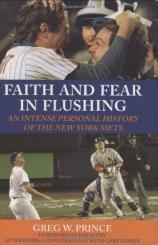 Such mania carried over to the team that replaced the Dodgers (and the New York Giants, who moved west with their archrivals), and devotees of the Mets still have their team on hand. (Ironically, their new ballpark was designed as a homage to Ebbets.) Greg Prince offers his bittersweet memories in FAITH AND FEAR IN FLUSHING: An Intense Personal History of the New York Mets. The author, who hosts a popular blog on the team, is an avowed, unabashed, 40-something Mets fan who is unapologetic about his devotion. As such, he had the luxury of bypassing the truly early days of the Mets as “lovable losers,” coming to the “Amazins” in their heyday when they won all the marbles in 1969. By the same token, he and his generation were spoiled by that success and disheartened with the nadir in the late ’70s, early ’80s and mid-’90s. But Prince is a true fan, sticking with his team through the ups and downs, and has little patience for fair weather followers.
Such mania carried over to the team that replaced the Dodgers (and the New York Giants, who moved west with their archrivals), and devotees of the Mets still have their team on hand. (Ironically, their new ballpark was designed as a homage to Ebbets.) Greg Prince offers his bittersweet memories in FAITH AND FEAR IN FLUSHING: An Intense Personal History of the New York Mets. The author, who hosts a popular blog on the team, is an avowed, unabashed, 40-something Mets fan who is unapologetic about his devotion. As such, he had the luxury of bypassing the truly early days of the Mets as “lovable losers,” coming to the “Amazins” in their heyday when they won all the marbles in 1969. By the same token, he and his generation were spoiled by that success and disheartened with the nadir in the late ’70s, early ’80s and mid-’90s. But Prince is a true fan, sticking with his team through the ups and downs, and has little patience for fair weather followers.
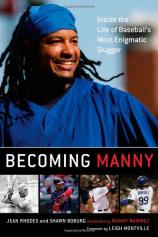 If pledging one’s allegiance to a single team might strike some as odd, what about focusing on a single player --- especially one who seems to confound, despite his brilliance on the field? In BECOMING MANNY: Inside the Life of Baseball’s Most Enigmatic Slugger, Jean Rhodes, a Ph.D. professor of psychology at the University of Massachusetts in Boston, and Shawn Boburg, a reporter for The Record, in Bergen County, NJ, combined their disciplines to produce this unusually detailed profile of Manny Ramirez. Delving into his upbringing in the Dominican Republic and later New York City, they show how a shy, family-oriented and talented athlete grew into the enigmatic superstar of today, known for episodes of curious behavior and occasional lapses into indifference. But under the surface, his is a fairly common tale of young, relatively uneducated ballplayers who are suddenly thrust into the world of celebrity, with all the money and attention it brings. Some can handle it well, many can’t. Whether Ramirez has is a matter of cultural interpretation.
If pledging one’s allegiance to a single team might strike some as odd, what about focusing on a single player --- especially one who seems to confound, despite his brilliance on the field? In BECOMING MANNY: Inside the Life of Baseball’s Most Enigmatic Slugger, Jean Rhodes, a Ph.D. professor of psychology at the University of Massachusetts in Boston, and Shawn Boburg, a reporter for The Record, in Bergen County, NJ, combined their disciplines to produce this unusually detailed profile of Manny Ramirez. Delving into his upbringing in the Dominican Republic and later New York City, they show how a shy, family-oriented and talented athlete grew into the enigmatic superstar of today, known for episodes of curious behavior and occasional lapses into indifference. But under the surface, his is a fairly common tale of young, relatively uneducated ballplayers who are suddenly thrust into the world of celebrity, with all the money and attention it brings. Some can handle it well, many can’t. Whether Ramirez has is a matter of cultural interpretation.
The recent revelations of Ramirez's use of performance-enhancing drugs and his subsequent 50-game suspension came as a shock to Rhodes, who told the Boston Herald that this was not the Manny she knew. She pointed out that even as a high school player, Ramirez demonstrated considerable power, so the numbers he has put up over the course of his Major League career should not be a lightning rod for suspicion.
 If the aforementioned books might cause occasional head-scratching, two new coffee tables books remind us of the grand and glorious history of one team in particular and the national pastime in general.
If the aforementioned books might cause occasional head-scratching, two new coffee tables books remind us of the grand and glorious history of one team in particular and the national pastime in general.
YANKEE COLORS: The Glory Years of the Mantle Era, with photographs by Marvin E. Newman and text by Al Silverman, bring to life the legendary teams of the 1950s and ’60s. Many of these shots have never been seen before in a project like this. The full-page artwork is gorgeous, dramatic and a baby-boomer Yankee fan’s dream, as they call to mind the fall classics against the Dodgers, Reds, Pirates and others. There are also candid shots of the Bronx Bombers, joking around at leisure, a side that isn’t often seen.
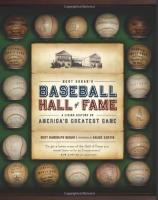 There have been several fine books showcasing the treasures in baseball’s ultimate museum, but few combine the combination of a sense of history and the fun of memorabilia as BERT SUGAR’S BASEBALL HALL OF FAME: A Living History of America’s Greatest Game. This lushly illustrated offering takes the reader on a guided tour of the repository of the game’s history, moving from room to room and topic to topic, including exhibits of women in baseball and “The African-American Baseball Experience.” And it’s not just the players (there’s a section on the plaques of every man inducted into the Hall) and notable events that receive attention. There were plenty of people behind the scenes --- broadcasters, announcers and executives, among others --- who were just as important and influential as any slugger or pitching ace. Sugar even gives a look into the “support” areas, such as the A. Bartlett Giamatti Research Center and the Gift Shop. After all, what’s a trip to the Hall of Fame without a souvenir?
There have been several fine books showcasing the treasures in baseball’s ultimate museum, but few combine the combination of a sense of history and the fun of memorabilia as BERT SUGAR’S BASEBALL HALL OF FAME: A Living History of America’s Greatest Game. This lushly illustrated offering takes the reader on a guided tour of the repository of the game’s history, moving from room to room and topic to topic, including exhibits of women in baseball and “The African-American Baseball Experience.” And it’s not just the players (there’s a section on the plaques of every man inducted into the Hall) and notable events that receive attention. There were plenty of people behind the scenes --- broadcasters, announcers and executives, among others --- who were just as important and influential as any slugger or pitching ace. Sugar even gives a look into the “support” areas, such as the A. Bartlett Giamatti Research Center and the Gift Shop. After all, what’s a trip to the Hall of Fame without a souvenir?
--- Reviewed by Ron Kaplan


